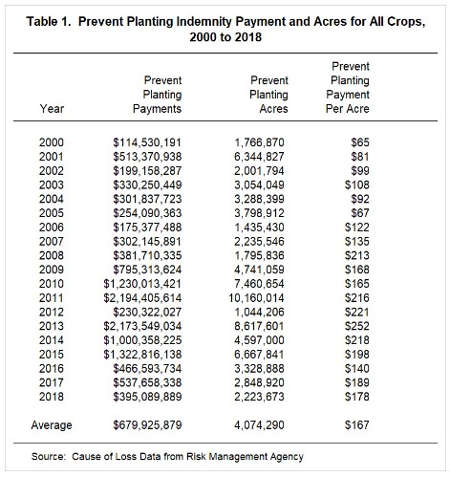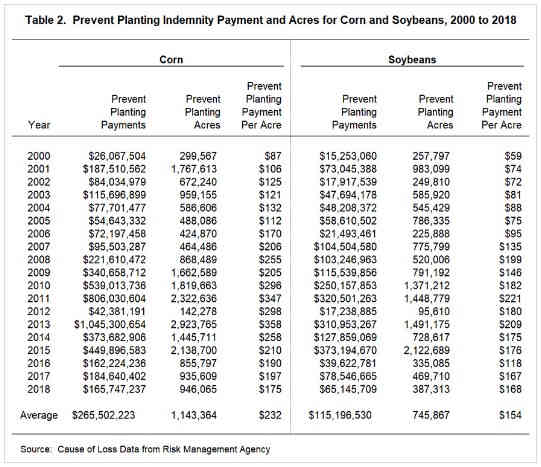By Gary Schnitkey
Department of Agricultural and Consumer Economics
University of Illinois
Historical data is used in this article to arrive at estimates of prevent planting payments in 2019. Based on historical information, per acre payment rates of $308 per acre for corn and $138 per acre for soybeans seen reasonable. Then, 8 million of prevent plant acres of corn would yield $2,464 million on corn payments. Soybean payments would be $414 million if prevent planting acres for soybean is 3 million acres. Given other prevent plant payments, a total of $3,578 million of prevent planting payment seem possible for 2019. This payment would exceed the $2,194 million previous high set in 2011. These estimates are preliminary and will come into clearer focus as more information on prevent plant acres become available.
Historical Prevent Planting Payments
From 2000 to 2018, prevent planting payments for all crops averaged $680 million per year, with an average of 4,074,000 acres of prevent planting. The average payment was $167 per acre (see Table 1). As would be expected, prevent planting payments range over that period, with a high of $2,194 million in 2011 on 10,160,000 acres. The lowest number of payments occurred in 2000 when $115 million of prevent planting was paid on 1,767,000 acres.

Corn Payments
Corn represents about 28% of the prevent planting acres in a typical year. Overall, wheat averages slightly higher than corn, representing 29% of prevent plant acres. The crop with the next most acres is soybeans with an average 18% of prevent plant acres. These three crops have averaged 75% of the prevent planting acre from 2000 to 2018.
From 2000 to 2018, corn averaged $266 million in prevent planting payments (see Table 2). The highest was $1,045 million in 2013 on 2,923,000 acres. The lowest total payment occurred in 2000 when prevent planting indemnities were $26.0 million.

For corn, per acre prevent planting payments exhibit variability. The highest per acre rate of $358 per acre occurred in 2013. The lowest was $87 per acre in 2000.
Historically, three factors explain 87% of the variability in per acre rates. In order of importance, these factors are:
- Projected price. Higher projected prices result in higher guarantees. When prevent planting occurs, a higher prevent planting payment results from a higher guarantee. Projected prices were over $5.00 per bushel in 2011 ($6.01), 2012 ($5.58), and 2014 ($5.65). These three years also were associated with the three highest per acre payments (see Table 2).
- Acres of prevent planting. Higher prevent planting acres brings more productive farmland into prevent planting, resulting in higher per acre payments. Historically, a 1,000,000 acres increase in prevent planting results in a $19 higher prevent planting payment.
- Change in prevent planting rate. Prior to 2017, the standard prevent planting payments factor for corn was .60. This was lowered to .55 in 2017. The lowering of this payment rate is associated with a $5 reduction in payments per acre.
Soybean Payments
Soybean payments averaged $115 million from 2000 to 2018 (see Table 2). Again, there is variability, with a high of $373 million in 2015, and a low of $15 million in 2000.
The per acre payment from 2000 to 2018 averaged $154 per acre. Similar to corn, there was variability in payment rates, ranging from a low of $59 per acre in 2000 to a high of $221 per acre in 2011. Two factors explain 95% of the variability in historical rates:
Projected prices. Higher projected prices result in higher guarantees, which then result in higher per acre payments.
Acres of prevent planting. As acres increase, per acre prevent planting payments also increase. A 1,000,000 acre increase results in a slight increase in per acre payments.
2019 payments
For estimating 2019 payments, corn is estimated to have a $308 per acre rate. The $308 estimate begins with the $175 per acre rate for 2018. Because projected prices are roughly the same in 2018 and 2019 — $3.94 in 2018 and $4.00 in 2019 – no adjustments are made for changes in projected price. An additional 7 million additional acres than normal (1.1 million) acres assumed to be in prevent planting, resulting in an increase in rate of $133 per acre (7 x $19). This gives the $308 rate.
A $138 per acre rate will be used for soybeans. The $138 rate results from an adjustment downward from the $154 per acre level in 2018 because of a lower projected price. The projected price in 2019 is $9.54 per bushel, down from the $10.15 level in 2018.
Reasonable estimates of prevent planting acres at this point are difficult. Estimate of 8 million acres of prevent plant corn and 3 million acres of prevent plant soybeans are used. These results in $2,464 million of prevent plant payments for corn and $414 million for soybeans. Adding in $700 million for prevent plant payments on other crops results in an estimate of $3,578 million in prevent planting payments.
Commentary
An estimate of $3,578 million would be about $2,700 million higher than the previous high of 2,100 million in 2011 and 2013. Obviously, higher or lower numbers of prevent planting acres will impact that estimate.
Per acre values used in this article may be low. Prevent planting this year will be occurring on many acres with higher productivity than the normal prevent plant acre. Those acres could result in higher per acre rates.
Source: farmdocdaily